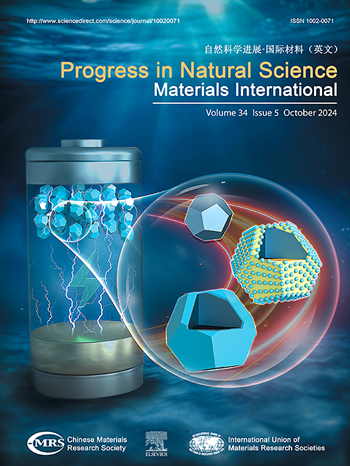聚电解质诱导的高可加工颜料状光子晶体墨水
IF 4.8
2区 材料科学
Q2 MATERIALS SCIENCE, MULTIDISCIPLINARY
Progress in Natural Science: Materials International
Pub Date : 2024-10-01
DOI:10.1016/j.pnsc.2024.07.022
引用次数: 0
摘要
开发一种构建高度可加工光子晶体(PC)的简单策略对于各种应用至关重要,但这仍然是一项挑战。在这里,我们提出了一种简单的聚电解质诱导自组装策略,通过在超低浓度的胶体纳米粒子溶液中加入聚电解质,生产出具有出色加工灵活性的新型光子晶体(PC)油墨。聚电解质可通过氢键作用覆盖纳米粒子,同时诱导它们聚集和相互排斥,使超低浓度(0.01-1.0 v/v%)的纳米粒子自组装成具有与角度无关的结构颜色的短程有序阵列。由于 PC 油墨的流变特性可通过改变聚电解质的性质进行广泛调整,因此所产生的 PC 油墨具有前所未有的类似颜料的色彩调制能力,以及超高的加工方法自由度。因此,PC 油墨可以通过注塑、书写、绘制和三维打印等各种技术轻松塑造成复杂精美的多色图案/三维结构。这种通用方法为快速、可扩展地生产实际应用所需的先进 PC 材料铺平了道路。本文章由计算机程序翻译,如有差异,请以英文原文为准。
A polyelectrolyte-induced highly processable pigment-like photonic crystal ink
Developing a straightforward strategy for constructing highly processable photonic crystals (PCs) is crucial for various applications, yet remains a challenge. Here, we present a simple polyelectrolyte-induced self-assembly strategy for producing novel photonic crystal (PC) inks with outstanding processing flexibility by adding the polyelectrolytes into the ultralow concentration of colloidal nanoparticle solution. The polyelectrolyte can cover the nanoparticles through the hydrogen bond interaction to induce the aggregation and mutual repulsion of them simultaneously, enabling the self-assembly of ultralow concentration (0.01–1.0 v/v%) of nanoparticles into short-range ordered arrays with angle-independent structural colors. The resulting PC inks present unprecedented pigment-like color modulation capacity, as well as ultrahigh freedom in processing methods due to the fact that the rheological behaviors of PC inks can be widely adjusted by varying the properties of polyelectrolytes. Consequently, the PC inks can be easily shaped into complex and exquisite multicolor patterns/3D structures using various techniques, including injection molding, writing, drawing, and 3D printing. This general approach paves the way for quick and scalable production of advanced PC materials deeply required in practical applications.
求助全文
通过发布文献求助,成功后即可免费获取论文全文。
去求助
来源期刊
CiteScore
8.60
自引率
2.10%
发文量
2812
审稿时长
49 days
期刊介绍:
Progress in Natural Science: Materials International provides scientists and engineers throughout the world with a central vehicle for the exchange and dissemination of basic theoretical studies and applied research of advanced materials. The emphasis is placed on original research, both analytical and experimental, which is of permanent interest to engineers and scientists, covering all aspects of new materials and technologies, such as, energy and environmental materials; advanced structural materials; advanced transportation materials, functional and electronic materials; nano-scale and amorphous materials; health and biological materials; materials modeling and simulation; materials characterization; and so on. The latest research achievements and innovative papers in basic theoretical studies and applied research of material science will be carefully selected and promptly reported. Thus, the aim of this Journal is to serve the global materials science and technology community with the latest research findings.
As a service to readers, an international bibliography of recent publications in advanced materials is published bimonthly.

 求助内容:
求助内容: 应助结果提醒方式:
应助结果提醒方式:


